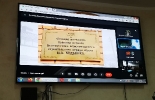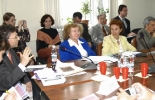«United States security provision: transformation of interpretations and interagency interaction in 2009–2020»
Preliminary idea of the research appeared after Donald Trump’s electoral victory in November 2016. The transition had been supplemented by intensive growth of facts interpretation influence on U.S. policy and anyone’s political strategy.
The posture brought to understanding that term security may be interpreted as governmental efforts to push system to a track which the government decided as an optimal and safety one for the state. This problem is researched on examples of Barack Obama’s and Donald Trump’s presidencies. In chapter 1 “Methodological problems of security modeling” different discipline’s basic approaches to social phenomena modeling are analyzed. The result let to interpret security modeling as a trans-disciplinary problem which is possible to solve in a manner of borrowing and mutual adaptation of history, philosophy, political science, mathematics, physics and cybernetics several provisions. In chapter 2 “Elaboration of a new security provision model” it let to view United States as a system consists of 16 subsystems which interact mutually in accordance with laws suggested by the system independently and used by the system to involve people in its activities. Such understanding made the view at the phenomenon as objective as possible. To reach the purpose indirect coding language had been developed. It let to translate strategies’ priorities into numbers and symbols codes which take into consideration non-mathematical and non-physical nature of society and follow its existence peculiarities. This language and results of global modeling provided in 1980ths made possible to create a frame of the model and supplement it by algorithm for practical use. Chapter 3 “United States security provision: outlines of interpretations’ system” opens practical part of the research. Here investigation brought to invention of three self-generated control mechanisms which let US system to be both stable and innovative one. Also, phenomenon of methacontrol had been isolated. System generated it to control lower levels control mechanisms. Chapter 4 “Structure and transformations of priorities” is devoted to more complicated control mechanisms derived from the structure of strategies and priorities adopted by a government. The ones bring any subsystem to its place suggested by executive power vision and establish interconnections among subsystems. Most of the control mechanisms are grouped into complexes. Also, phenomenon of relation as a control one is isolated. Possibility of a control mechanism to connect different levels (metha)control mechanisms and to control them is called relation. In chapter 5 “Specifics of U.S. dynamics and bifurcation mechanisms” U.S. historical dynamical time of late 20th – early 21st centuries general posture is drawn. It is understood as a combination of cyclical, directed and irregular temporal processes. The character of dynamics, mutual interaction and context of political parties’ roles establish six bifurcation mechanisms which are understood as ones of further vector of development choosing by the system, but the frame of the alternatives doesn’t mean the system break or collapse. On the contrary, the mechanisms let United States to remain a system with highly adaptive potential. Chapter 6 “Non-Identified priorities: its place and role in system of interpretations” is devoted to non-identified priorities which are difficult to mark with any subsystem code because of too general definition, its geographical character and content of other related documents. Such priorities establish additional interconnections among strategies, stress importance of any subsystem, serve for political continuity from one president to another. This investigation let to reconstruct networks of U.S. security interpretations and related interagency interaction for Barack Obama’s and Donald Trump’s terms in chapter 7 “Networks of structural ties and interagency interaction”. It let to isolate that common understanding of security had been divided into three clusters (economic, military and civil-humanitarian) for period of 2009–2016. So, trade, military, civil and humanitarian fields had been the pillars of B. Obama’s overall security strategy of the United States. In 2015–2016 under influence of the military overall US strategy disintegrated and 44th president didn’t manage to establish a new one in the same manner. Unlike his predecessor D. Trump built integrated system of US security interpretations and set technology development as its core. In chapter 8 “United States security provision: interpretations and interactions system in temporal context” Barack Obama’s and Donald Trump’s policies are presented as peculiar phenomena of a common field. Also, structure of strategies adopted in 2014–2015 let to isolate that B. Obama’s policy in last two years of his presidential term contributed to D. Trump’s victory. Their presidential terms had been connected by temporal historical processes, and by factors of US civilization. Chapter 9 “Indirect coding: sense of experiment and language application prospects” is devoted to the model practical application in field of political analysis and international relations, its new potential interdisciplinary ties are suggested. Also, it includes some indirect coding language improvements for several practical purposes related to fields of regional studies, regional development, domestic and foreign policy, international relations. The monograph is supplemented by new terms glossary, tables, pictures and coding map.
email: email hidden; JavaScript is required







